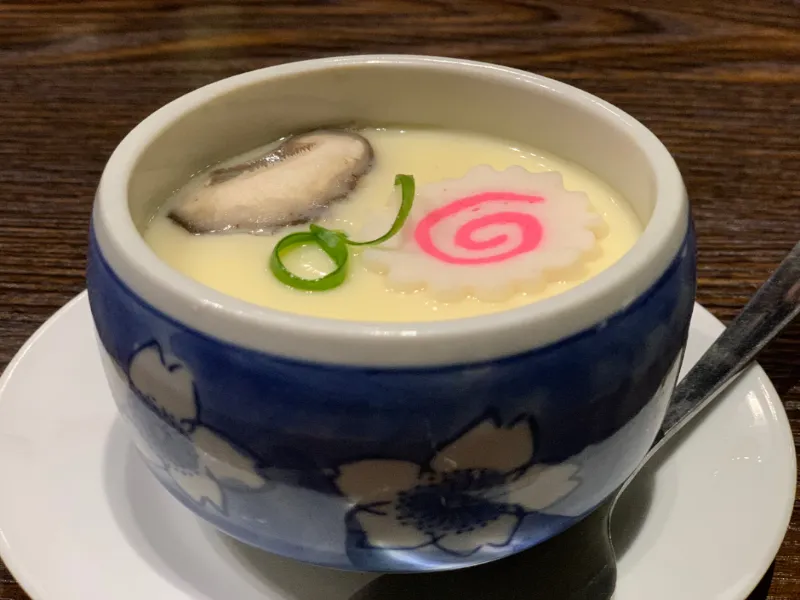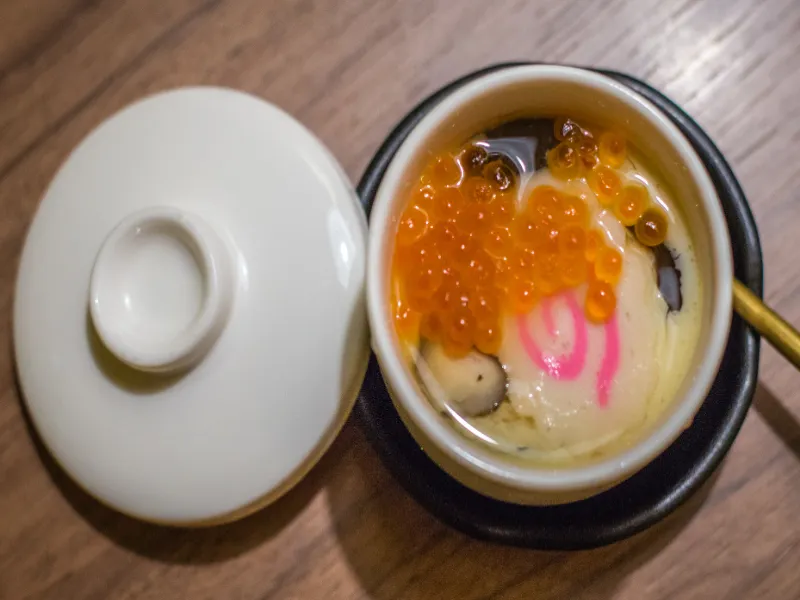Mastering the Art of Chawanmushi

Table of Contents
Chawanmushi, a traditional Japanese dish, has gained immense popularity for its delicate flavours and velvety texture. Steeped in history and culinary finesse, this savoury steamed egg custard has become a sought-after delight for food enthusiasts around the globe.
We take immense pleasure in sharing our expertise and knowledge of Chawanmushi, offering you a comprehensive guide to mastering this exquisite dish. Join us on a captivating journey as we explore the intricate details, secrets, and techniques of creating a perfect Chawanmushi that will tantalize your taste buds and leave you yearning for more.
Unveiling the Essence of Chawanmushi
Chawanmushi, derived from the Japanese words “chawan” meaning tea bowl or bowl, and “mushi” meaning steamed, is a culinary masterpiece that beautifully combines simplicity and elegance. Traditionally, Chawanmushi features a harmonious blend of ingredients such as ginkgo nuts, shiitake mushrooms, kamaboko fish cake, and an egg mixture flavoured with dashi, soy sauce, and mirin. The resulting custard-like texture, coupled with the umami-rich flavours, makes Chawanmushi a true delight for both the eyes and the palate.
Crafting the Perfect Chawanmushi
To create a Chawanmushi that stands out, it is essential to pay attention to each element of the dish. Let us dive into the key components and techniques that will enable you to create an outstanding Chawanmushi experience.
1. The Foundation: A Flavoursome Stock
A good stock serves as the foundation for an excellent Chawanmushi. While dashi stock is the traditional choice, you have the flexibility to explore alternatives such as chicken stock based on your preference. The stock primarily comprises kombu (dry kelp) and katsuobushi (dried bonito flakes), infusing the custard with deep, savoury notes.
The egg to stock ratio plays a crucial role, determining the custard’s firmness. Achieving the perfect balance is key, as an excess of stock may cause the custard to break, while too little can result in a less silky texture.
2. The Delicate Dance: Ingredients and Fillings
Selecting the right ingredients and fillings is a crucial step in creating an exceptional Chawanmushi. The possibilities are vast, ranging from diced chicken meat and kamaboko (steamed fish cakes) for a simple yet delightful experience, to indulgent additions such as dried scallops, shrimps, ginkgo nuts, and shiitake mushrooms for a more luxurious touch.
When assembling the ingredients, aim for an aesthetically pleasing arrangement by stacking them loosely in the bowl. Colourful ingredients like carrot slices, mushrooms, and mitsuba are best placed on top, while ingredients like chicken, prawns, and gingko nuts are traditionally nestled beneath the surface, offering a delightful surprise when savoured.
3. The Art of Steaming: Time and Temperature
Mastering the art of steaming is pivotal in achieving the desired consistency and texture for your Chawanmushi. Steaming is a cooking method that utilizes moist heat generated by boiling water, which vaporizes into steam. Unlike boiling, where the food is submerged in water, steaming keeps the food separate from the water, allowing it to come into direct contact with the steam.
The Importance of Time and Temperature
When it comes to steaming Chawanmushi, precise time and temperature play crucial roles in achieving the perfect custard-like texture. While the recipe provides general guidelines, it’s essential to adapt them based on factors such as the size of the bowl and the stove being used.
Finding the Perfect Balance
The duration and temperature of steaming are interdependent factors that require careful consideration. Steaming Chawanmushi involves finding the perfect balance to ensure thorough cooking while maintaining a silky and delicate texture.
Timing Is Key
The duration of steaming depends on the size of the Chawanmushi bowl and the desired firmness of the custard. As a general guideline, aim for a steaming time of around 15 to 20 minutes.
However, it’s essential to monitor the custard’s consistency and appearance during the process. Adjust the steaming time accordingly to achieve the desired texture. Keep in mind that different stove types may require slight variations in cooking time.
Temperature Control
Maintaining the appropriate steaming temperature is equally important. Generally, steaming Chawanmushi at a medium heat setting is recommended. This allows for gentle and even cooking without subjecting the custard to harsh heat that may result in overcooking or uneven textures.
Ensuring Food Safety
While achieving the desired texture and consistency is essential, it’s equally crucial to ensure food safety. Steaming is an effective method for cooking, and it can also be used to eliminate harmful bacteria and parasites in meat. To ensure food safety, it’s recommended to use a food thermometer to check the internal temperature of the meat.
4. The Perfect Harmony: Mixing the Egg Mixture
The egg mixture is a crucial component that binds together the flavors and textures of Chawanmushi. To ensure a smooth and even consistency, it’s important to handle the egg mixture with care. Begin by lightly beating the eggs to avoid excessive bubble formation.
Large bubbles can lead to an uneven surface, compromising the visual appeal of the dish. For convenience, mix the beaten eggs with the dashi stock before straining. This step eliminates the need to strain the egg liquid separately, reducing the chances of introducing additional bubbles into the mixture.
5. The Steaming Symphony: Time and Temperature Mastery
Steaming plays a vital role in achieving the perfect texture and doneness of your Chawanmushi. While the suggested duration and temperature in the recipe serve as a general guideline, it’s essential to adapt them based on factors such as the size of the bowl and the stove you are using. Pay attention to the custard’s consistency and appearance during the steaming process, as this will allow you to make necessary adjustments for future preparations.
6. The Finishing Touch: Presenting the Chawanmushi

Presentation is key when it comes to elevating the dining experience. To present your Chawanmushi in an appealing manner, consider using Chawanmushi cups with lids. These cups not only enhance the visual allure but also help retain heat and moisture, ensuring a delightful serving temperature.
If Chawanmushi cups are not available, don’t fret! Any small bowls or ramekins can be used as substitutes. Simply cover them with aluminium foil or cling wrap during the steaming process to create the desired cooking environment.
Chawanmushi FAQ
1. Why is my chawanmushi not smooth?
This might be due to excessive bubbles in your egg mixture or lumps that have not been properly strained out. Ensure that you beat your eggs gently to avoid introducing too much air. Strain your mixture to remove any lumps or air bubbles.
2. Why is my chawanmushi so watery?
The egg to stock ratio is crucial in determining the texture of your chawanmushi. Too much stock can lead to a watery custard. A commonly used ratio for chawanmushi is 1:2 (egg to stock).
3. When should I eat chawanmushi?
This information wasn’t directly provided in the search results. However, chawanmushi is typically served as a side dish or appetizer in Japanese cuisine, so it would typically be eaten at the start of a meal.
4. What is chawanmushi in Chinese?
Chawanmushi is a specific dish from Japanese cuisine, and the term itself is Japanese. It translates literally to “steamed in a tea bowl.” There isn’t a direct translation for the term “chawanmushi” in Chinese as it is a dish specific to Japanese cuisine.
5. Why is my egg mixture not fluffy?
This could be due to various factors such as the eggs not being beaten sufficiently or the mixture being overbeaten. Make sure to beat the eggs gently and avoid introducing too many air bubbles that could collapse and result in an uneven texture.
6. Why is my steamed egg not silky?
This could be due to incorrect proportions of egg to liquid. For a silky texture, the egg to water ratio should be about 1:1.7. Additionally, strain your egg mixture to remove any lumps or excess air bubbles.
7. How do you stop eggs cracking when steaming?
This question seems to refer to whole eggs rather than the steamed egg custard dish. Typically, to prevent cracking, eggs should be at room temperature before steaming and should be steamed at a low, steady temperature.
8. Why do eggs crack when steaming?
Again, this question seems to refer to whole eggs. If eggs are introduced into a hot steamer directly from the refrigerator, the sudden change in temperature may cause them to crack. It’s best to bring the eggs to room temperature before steaming them.
9. Does water help make eggs fluffy?
Yes, adding a little water (or milk) to beaten eggs before cooking them can create steam as they cook, resulting in a fluffier texture.
10. How do you know when steamed eggs are done?
The exact timing can vary depending on the size of your bowls and your stove, but a good general rule is to check if the custard is set and doesn’t liquid when you gently shake the dish. Additionally, you can insert a toothpick or skewer; if it comes out clean, your custard is done.


